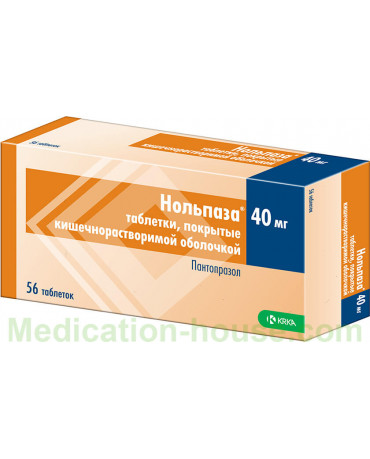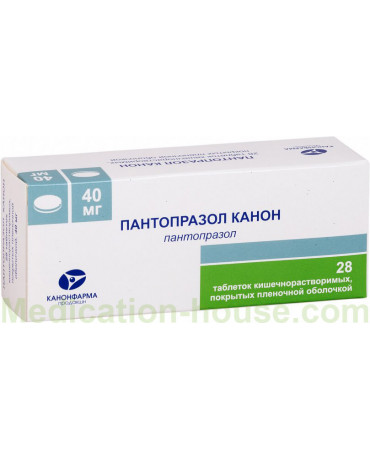Release form and composition of Sanpraz
enteric-coated tablets: biconvex, round, yellow (in aluminum strips of 10 pieces, in cardboard packaging 1-3 strips).
Each pack also contains instructions for the use.
Composition per tablet
active substance: pantoprazole (in the form of pantoprazole sodium sesquihydrate) - 40 mg;
auxiliary components: calcium stearate, magnesium oxide, colloidal silicon dioxide, sodium lauryl sulfate, calcium carbonate, crospovidone;
enteric coating: copovidone, macrogol 6000, copolymer of methacrylic acid and ethyl acrylate, titanium dioxide, triethyl citrate, yellow iron oxide, talc.
Pharmacodynamics
The active substance in the composition of the drug Sanpraz - pantoprazole, is an inhibitor of hydrogen-potassium adenosine triphosphatase (H + / K + -ATPase). It blocks the last stage of the secretion of hydrochloric acid (HCl), thereby reducing its basal and stimulated secretion, regardless of the nature of the stimulus. Pantoprazole in patients with duodenal ulcer associated with Helicobacter pylori reduces gastric secretion and increases the sensitivity of bacteria to antibiotics.
When taken orally, Sanpraz does not affect the motility of the gastrointestinal tract (GIT).
Intravenous administration of pantoprazole at a dose of 80 mg provides the maximum antisecretory effect after 1 hour and retains it for 24 hours. Secretory activity is normalized 3-4 days after the completion of the therapeutic course.
Pharmacokinetics
After oral administration of Sanpraz, pantoprazole is rapidly absorbed from the gastrointestinal tract. The maximum concentration (Cmax) in plasma reaches after 2.5 hours, this indicator is 2-3 mg / l, remaining unchanged even with multiple doses. Other characteristics: bioavailability - 65–77%, half-life (T1 / 2) - about 1 hour.
After intravenous administration in the dose range of 10–80 mg, the pharmacokinetic parameters of pantoprazole show a linear dependence, their values with repeated and single use are comparable. The drug does not cumulate in the body.
Distribution volume (Vd) is 0.15 L / kg; Sanpraz is distributed predominantly in extracellular fluid. It binds to plasma proteins at 98%.
Pantoprazole is extensively metabolized in the liver, mainly with the participation of the CYP2C19 cytochrome P450 system. The main metabolite detected in urine and blood plasma is desmethyl pantoprazole sulfate-conjugated.
After parenteral administration, T1 / 2 averages 1 hour. The bulk of pantoprazole is excreted as inactive metabolites by the kidneys. A small amount is excreted through the intestines.
In renal failure, the pharmacokinetics of pantoprazole does not significantly change.
In patients with hepatic insufficiency, T1 / 2 rises to 7–9 hours. The area under the concentration – time curve (AUC) increases 5–7 times, and Cmax - 1.5 times as compared with the same parameters in healthy volunteers.
Indications for use
gastrinoma (Zollinger-Ellison syndrome);
destruction of the bacterium Helicobacter pylori (Helicobacter pylori) (as part of combination therapy with antibacterial agents);
exacerbation of gastric ulcer and 12 duodenal ulcer;
erosive (hemorrhagic) gastritis associated with the Helicobacter pylori bacterium;
erosive and ulcerative lesions of the stomach and duodenum due to the use of NSAIDs (non-steroidal anti-inflammatory drugs);
treatment of GERD (gastroesophageal reflux disease);
treatment and prevention of stress ulcers, as well as their complications (bleeding, penetration of ulcers, perforation).
Contraindications
dyspeptic disorders of neurotic etiology;
malignant neoplasms of the gastrointestinal tract;
children and adolescents under 18 years of age (since there is no data on the use of Sanpraz in pediatric practice);
lactation period (for solution);
increased individual sensitivity to any of the components of the drug.
With caution, Sanpraz is prescribed for pregnant women and patients with liver failure.
According to the doctor's prescription, the drug in the form of tablets can be used with caution during breastfeeding.
Instructions for use: method and dosage
Tablets are intended for oral use. The drug is taken in the morning, one hour before a meal. When prescribed twice a day, the second dose is taken before dinner (one hour). The tablet is swallowed whole and washed down with a sufficient amount of liquid.
For adults, Sanpraz is prescribed in the following doses:
destruction of Helicobacter pylori: 1 tablet twice a day. The course is 1-2 weeks. Treatment is combined with the use of antimicrobials;
hemorrhagic gastritis, peptic ulcer of the stomach and duodenum: 1-2 tablets per day. The course of treatment: exacerbation of gastric ulcer - 1-2 months, exacerbation of duodenal ulcer - 2 weeks;
erosive and ulcerative lesions due to NSAIDs: 1-2 tablets per day. The course of treatment is 1-2 months. With prolonged use of NSAIDs, Sanpraz is used prophylactically for ½ tablets per day;
GERD: ½-1 tablet per day, course of treatment - 1-2 months; for the prevention of possible complications - ½ tablet per day.
In severe hepatic impairment, dosage adjustment is required. Sanpraz is taken every other day by 1 tablet, regularly monitoring the biochemical parameters of the blood. With an increase in liver enzyme activity, Sanpraz should be discontinued.
If oral administration is not possible, intravenous administration of the drug is used. As soon as it becomes possible to take Sanpraz inside, the patient is transferred to the oral form of the drug.
To prepare the solution, it is necessary to restore the bottle with lyophilisate using the solvent that comes with the kit. The resulting solution of Sanpraz is administered intravenously by stream or in the form of an infusion lasting from 2 to 15 minutes. To prepare the infusion solution, the reconstituted lyophilisate is mixed with 100 ml of an isotonic NaCl solution or a 5% or 10% glucose solution. The prepared solution should have a pH of 9-10. The shelf life of the infusion solution is 3 hours from the date of preparation.
With the intravenous administration of Sanpraz, the recommended dose is 40 mg once a day. The duration of therapy is 7-10 days, if necessary, the course of treatment can be extended.
With Zollinger-Ellison syndrome, Sanpraz is used for a long time, while the initial daily dose can be up to 80 mg, then it is corrected (increase or decrease). When prescribing the drug in a dose of more than 80 mg per day, it is divided into two injections. In some cases, a temporary increase in the daily dose to 160 mg is required.
In order to eradicate the bacteria, Helicobacter pylori Sanpraz is prescribed in a daily dose of 80 mg in two doses. Duration of use is from 7 to 10 days (treatment is carried out in combination with antimicrobial agents).
In severe liver dysfunction, dose adjustment is required. The daily dose of the drug should not exceed 20 mg. Regular monitoring of blood biochemical parameters is required. With an increase in liver enzyme activity, Sanpraz should be discontinued.
Elderly patients and persons with impaired renal function, the drug is prescribed in recommended doses, correction of the dosage regimen is not required.
Side effects
digestive system: dry mouth, pain in the upper abdomen, nausea and vomiting, constipation or diarrhea, functional failure of liver cells with jaundice, flatulence, increased activity of liver enzymes;
nervous system: impaired vision, headache, disorientation, dizziness, confusion, depression, weakness, hallucinations;
hematopoietic system: a decrease in the number of leukocytes and platelets;
musculoskeletal system: myalgia, arthralgia;
dermatological and allergic reactions: urticaria, itching and rash on the skin, photosensitivity, angioedema, Lyell syndrome, erythema multiforme, anaphylactic shock, Stevens-Johnson syndrome;
local reactions at the injection site: thrombophlebitis and phlebitis;
general reactions: peripheral edema, tenderness and tension of the mammary glands, interstitial nephritis, hyperthermia, increased triglycerides.
When using the drug according to the indications and in the prescribed doses, undesirable effects are very rare.
Overdose
Data on an overdose of Sanpraz when taken orally. With parenteral administration of the drug, doses up to 240 mg were well tolerated. Symptoms of pantoprazole overdose in humans are not known.
In case of overdose with signs of intoxication, general detoxification measures, symptomatic therapy, hemodialysis are recommended.
Special instructions
Treatment with Sanpraz can mask the signs of malignant neoplasms of the stomach or esophagus, therefore, mandatory endoscopic examination is recommended before starting pantoprazole and after the end of therapy.
With dyspeptic disorders of neurogenic etiology, the drug is ineffective.
Influence on the ability to drive vehicles and complex mechanisms
The drug did not affect the patient's ability to drive vehicles and engage in other potentially hazardous work associated with a high risk of harm to human health and life.
Pregnancy and lactation
Experience with the drug during pregnancy / lactation is limited. In experimental studies of the effect of the drug on reproductive function, insignificant embryotoxicity was observed with parenteral use of pantoprazole in a dose of more than 5 mg / kg.
Recommendations for use depending on the form of release:
film-coated tablets: during pregnancy / lactation is prescribed with caution;
lyophilisate for the preparation of a solution for intravenous administration: during pregnancy, it is used if the benefits to the mother are exceeded over the possible risk to the fetus; since there is no data on the allocation of pantoprazole with breast milk, breastfeeding should be discontinued during therapy.
Use in childhood
It is contraindicated to use Sanpraz in pediatrics for the treatment of children and adolescents under the age of 18 years.
With impaired renal function
Patients with renal failure, including those on hemodialysis, there is no need to increase the daily dose of pantoprazole above 40 mg.
With impaired liver function
For severe (severe) impaired liver function, it is recommended to take the following doses of pantoprazole:
film-coated tablets: 40 mg once every two days;
lyophilisate for solution for intravenous administration: 20 mg per day.
Patients with impaired hepatic function require regular monitoring of blood biochemical parameters. In case of increased activity of hepatic enzymes, Sanpraz is canceled.
Use in old age
Elderly patients do not need to increase the daily dose of pantoprazole above 40 mg.
Drug interaction
With the simultaneous use of the drug Sanpraz with ritonavir, ketoconazole and iron salts, their absorption rate decreases; with atazanavir - the effectiveness of atazanavir decreases; with warfarin - the prothrombin time increases and the risk of bleeding increases, sometimes with a fatal outcome.
No clinically significant drug interactions were found with the following drugs: ethinyl estradiol / levonorgestrel, nifedipine, ethanol, amoxicillin, caffeine, digoxin, metronidazole, diclofenac, cisapride, naproxen, glibenclamide, cyclosporine, diazepam, sodium levothyroxine, tamenzimen carbene, pirenolezin, tamenrolin , phenazone, theophylline, clarithromycin, metoprolol.
Terms and conditions of storage
Store in a dry, dark place out of the reach of children, at a temperature not exceeding 25 ° C. Shelf life: tablets - 3 years, lyophilisate - 2 years, solvent - 3 years.
Reviews
Due to its high efficiency, ease of administration, convenient form of release, most reviews of Sanpraz, especially in the form of tablets, are positive. The drug successfully suppresses the release of hydrochloric acid in the stomach, quickly and permanently relieves heartburn. The effect of the reception comes quickly, and there are practically no complaints from patients about side effects.
The disadvantage is often called the high cost of the drug.
Terms of sell
You don't need a prescription to buy Sanpraz.





